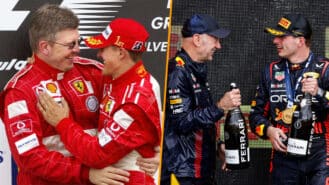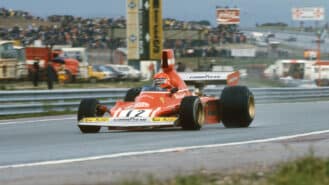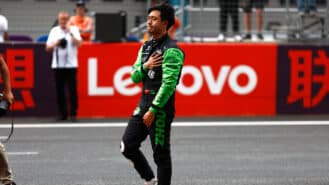Denis Jenkinson has been gone for nearly 20 years now, yet still there are times – many times – when something happens in the world of Formula 1, and I find myself wondering, ‘Now what would Jenks would have made of this…?’

We were close friends for a very long time, and I like to think that – on most occasions, anyway – I could take a stab at his reaction to this or that, and not be too far from the mark. Given his passion for absolute combativeness in a racing driver, for example, it’s beyond doubt that Jenks would have been a fan of Alonso, just as he was of Moss and Villeneuve and Senna, and equally certain, given his esteem of the man, is that he would have been much gratified by Adrian Newey’s continuing success down the years.

When it came to racing cars, though, DSJ’s primary passion always lay with engines – with horsepower – and it should surprise no one that the turbo era (pioneered by Renault in 1977, and running through to the end of ’88) was his favourite period of Grand Prix racing. At the end of it, he was disappointed by the FIA’s introduction of the 3.5-litre normally-aspirated F1 engine, dismayed when this was later reduced to 3-litres, and I really don’t care to think about what he would have made of the 2.4-litre V8.
A while ago Martin Brundle spent a day at Fiorano, and if driving an F1 Ferrari had always been one of his dreams, one aspect of the experience was a disappointment. “As always when I get in a current F1 car, I was blown away by the turn-in, the grip, the brakes… but the engine wouldn’t pull the skin off a rice pudding, and the 2.4 V8s are all like that. Completely underwhelming – nothing like a 3-litre V10, which in turn paled into insignificance compared with a turbo, of course…”
“Occasionally,” says Brundle, “you have a conversation about the turbo days with someone like Gerhard [Berger] or Derek [Warwick] – and honestly it’s like talking with someone who just knows something that no one else in the world knows.

“It could be utterly terrifying, particularly with qualifying tyres on, at a circuit where the walls were close. It was a truly eye-opening experience, for example, to go up the hill at Monaco on qualifying boost – I mean, you suddenly had 400 horsepower more than you’d had before!”
In terms of fun, sheer driving pleasure, Alain Prost remembers 1986 as his favourite year: “After that, they spoiled it by cutting back the boost, and the fuel you were allowed for a race…”
Berger agrees. “Yeah, ‘86 was definitely the best year – when boost was still free. The great thing was that not everyone could handle it – particularly with qualifying boost. Top of the hill at Monaco, into Casino Square, and you got wheelspin in top gear, even in the dry…
“In those days I didn’t have a lot of control over some things – all I thought about was my driving, you know, and I loved to have 5.5 bar boost. I was very sad when they banned the turbos – for the rest of my career I missed them. To handle one of those cars was difficult, because you had the throttle delay, you had to keep the boost up, you had to keep the wheels from spinning too much… and of course you had this unbelievable push forward. Going straight from F3 into one of those things, like I did… it seemed like the world had gone mad!

“I loved those cars. Some people say that the one thing they didn’t enjoy was the lack of instant engine response – but I liked that! I liked the fact that you arrived at a corner, and almost as soon as you turned in, you were on full throttle for the power you wanted 50 metres later! That was something, you know… to have the balls to go full throttle at a point where, if the power came too early, you were going to fly off the road. That was good fun – calculating where you had to push the throttle, and hoping you’d got it right! After that, anything else was going to be a disappointment, wasn’t it?”
Indeed it was. Anyone who witnessed it has never forgotten the sight of Ayrton Senna’s Lotus-Renault qualifying – boost off the clock – at Monte Carlo, and I have a particular memory of Piquet’s Brabham-BMW qualifying at Kyalami in 1983: so untrammelled was the impression of power into and through the Jukskei Sweep that one had the impression that it was only Nelson’s judicious dabs on the brake pedal that were keeping the thing on the ground…
After the turbo era, we had the 3.5-litre ‘atmospheric’ engines for six seasons, but following the loss of Senna and Roland Ratzenberger at Imola in 1994, there was not surprisingly an extreme focus on safety, on reducing speeds, and for ’95 capacity was reduced to three litres. By 2005, though, Mario Theissen of BMW told me they were routinely seeing more than 900bhp from their engines, and – again for reasons of safety, Max Mosley said – the FIA concluded that speeds needed trimming back once more, that the future lay with the 2.4-litre V8.

Not a moment too soon Formula 1 – spurred by a decline in many countries (if not the UK) in both TV viewing figures and race attendances – has embarked on a period of serious self-examination in an attempt to win back lost fans, and to attract new ones. After messing about with a number of cheap ideas, like double points at the last race and ‘standing restarts’ after safety car periods (both now mercifully dispensed with), the focus has switched to the actual product, to the quality of the spectacle, to making the cars more difficult to drive, this perhaps spawned by the thought that if youthful novices can swiftly set competitive times something is not as it should be.
So now suddenly all the talk is of the need for 1000bhp engines – indeed Niki Lauda has spoken of 1200 – in company with wider tyres, and as one who remembers how F1 was 30 years ago I am of course much in favour – just as, assuredly, would have been Jenks.
Let me finish with a snippet of conversation with Patrick Head about the 1986 season, when a Williams-Honda was the thing to have.
“Honda couldn’t tell us how much power we had, actually – because they didn’t know themselves! Their dyno only registered up to 1000 horsepower – which they were reaching at 9300rpm. We were revving them to 13,500 or so…”









